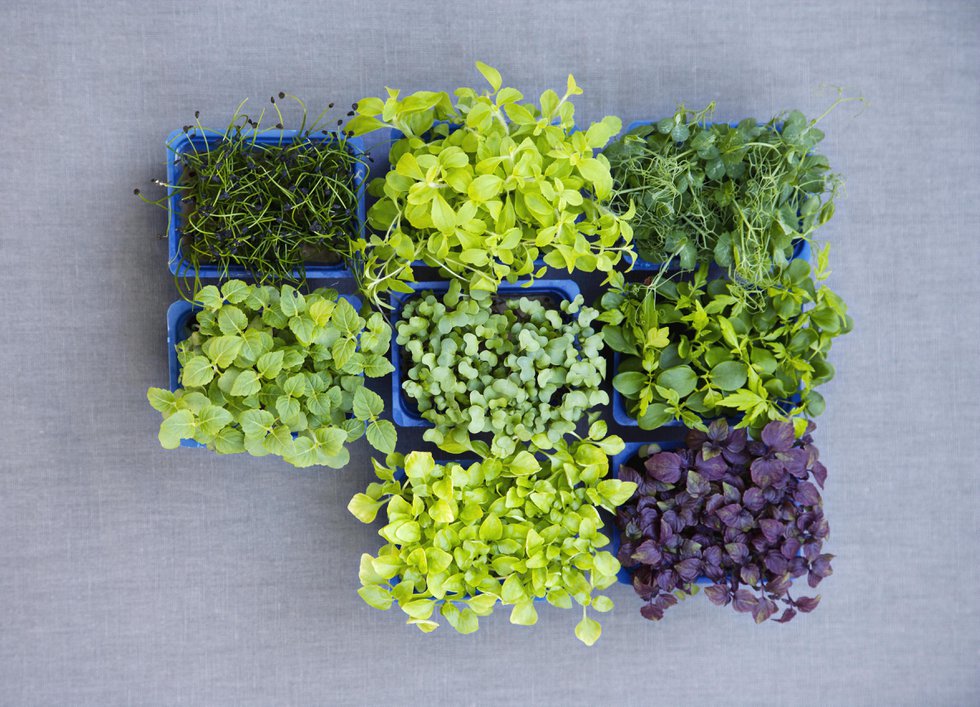Packed with flavor and nutrients, microgreens can power up your diet.

13238680
Various microgreens
You’ve probably noticed microgreens at farmers markets or natural food stores. But do you know what these nutrient-dense flavor bombs can do for your diet? While they emerged on the culinary landscape back in the 1980s, it’s only in recent years that microgreens have turned up in mainstream groceries across the state. Today, while many shoppers are still wondering what to do with them, nutritionists and trainers are counseling clients to embrace the mighty microgreen.
WHAT EXACTLY ARE MICROGREENS?

The first tiny seed leaves (known as cotyledons) are picked early in a plant’s growth cycle—at 10-14 days—microgreens are cultivated in soil or grown using hydroponic methods.
Unlike sprouts (which are typically grown in water and eaten roots and all), microgreens are cut with scissors above the soil line when they’re just an inch or two in height. The most popular versions are grown from plants we all recognize:
- Cauliflower, broccoli, cabbage, watercress, radish, and arugula all come from the Brassicaceae family.
- Lettuce, endive, chicory, and radicchio come from the Asteraceae family.
- Dill, carrot, fennel, and celery come from the Apiaceae family.
- Garlic, onion, and leeks are in the Amaryllidaceae family.
- Amaranth, quinoa, swiss chard, beets, and spinach are from the Amaranthaceae family.
- Melon, cucumber, and squash are from the Cucurbitaceae family.
WHY ARE THEY GOOD FOR US?
Researchers with the University of Maryland College of Agriculture and Natural Resources (AGNR) and the United States Department of Agriculture (USDA) compared nutrient levels in microgreens with the full-grown version of the same plant and found that the microgreens contained from four to 40 times more nutrients.
Sharon Palmer, author of The Plant Powered Diet, found that: “Since microgreens are harvested when the plants are not yet mature, they are rich in the nutrients and antioxidants needed to grow into full-blown plants.”
HOW TO USE THEM
Best eaten raw to preserve the flavor and nutrients, microgreens offer big rewards in a small package and can be used in a variety of ways—sprinkled on soups or added to sandwiches—to boost meals with flavor and nutrients.
“I tell clients that by adding microgreens into simple foods such as sandwiches, salads, and smoothies, they’ll boost the amounts of beneficial vitamins and antioxidants consumed by up to 40 times more,” says Jim White, a registered dietician and exercise physiologist certified by the American College of Sports Medicine. White owns the Jim White Fitness and Nutrition Studios in Norfolk and Virginia Beach, which offer medical nutrition therapy, workplace wellness, and other fitness services.
“People are surprised to learn about these tiny greens, and they’re thrilled to make this subtle adjustment to benefit from the rich nutrients in microgreens that they wouldn’t get from lettuce,” he notes.
WHERE CAN YOU FIND THEM?

11131033
A Poached Pear with Bulls Blood Microgreens
Look for microgreens on menus, in farmers markets, and in natural food grocers. A few of our favorite Virginia producers include:
CABBAGE HILL FARM
Chris Vaughan has been farming microgreens for 15 years. His popular Cabbage Hill Farm micro-mix contains 12 greens, including mustard, cabbage, kale, broccoli, arugula, and radish tops. He also sells some micro specialty greens like cilantro, dill, fennel, parsley, leeks, and basil.
Inspired by his mom’s Zesto Pesto business in Rochester, New York, Chris began making his own pesto combinations using microgreens, including a pea shoot and pistachio pesto, a cilantro and macadamia nut pesto, and a radish-cashew pesto. The intense flavor concentration in the microgreens and his creative use of different nuts create delicious and unique flavor profiles.
Cabbage Hill Farm sells produce and pesto to over 30 restaurants in Central Virginia. In Richmond, Cabbage Hill can be found at Belmot Butchery and Outpost, as well as at Byrd House Market and Big Market at Bryan Park.
LIL’ SPROUTS
A quest for nutrient-dense foods led Trent Jackson to microgreens. As a competitive high school soccer player, he found his answer in wheatgrass. He began selling it at his Colonial Heights high school before adding microgreens to the mix and selling to farmers’ markets and restaurants—all before moving to Richmond, enrolling in VCU’s DaVinci Center for Innovation.
At Lil’ Spouts, Jackson now grows five varieties of microgreens (sunflower, pea, radish, broccoli, and salad mix) indoors with organic soil and artificial light, supplying retailers like Ellwood Thompson’s, Good Foods Grocery, Libbie Market in Richmond, and Foods of All Nations in Charlottesville. He’s determined to dispel the myth that microgreens are expensive and inaccessible. “With microgreens, less is more,” says Jackson. “They’re more efficient—they’re essentially the caviar of greens.”
NOUVEAU FARMS
When his daughter was five, Trevor Ferguson searched for the perfect strawberries to satisfy her, and when he came up empty, Nouveau Farms was born. Originally from The Bahamas, Ferguson came to the U.S. to study engineering 20 years ago. That knowledge has helped him craft a technically-precise hydroponic growing system that is USDA GAP-certified (Good Agricultural Practices).
Ferguson sells nine varieties, plus herbs through Ellwood Thompson’s, Good Foods Grocery, and Libbie Market and statewide through the Seasonal Roots and 4P community supported agriculture (CSA) programs. To come are online sales with farm pickup.
This article originally appeared in the February 2022 issue.









